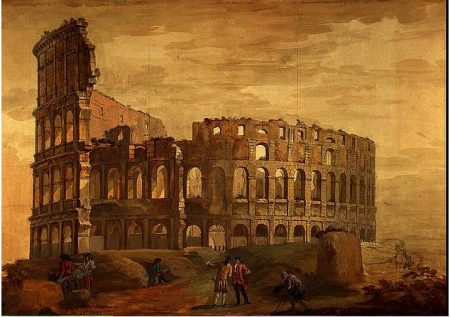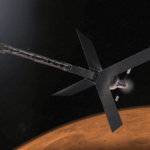January 25, 2019 – Before I entered the business world I was hellbent on becoming a history teacher. My undergraduate degree focused on the Medieval World and the rise of the Islamic Empire. I studied the historical period beginning with the world of the Roman Empire and ending with the fall of the Eastern Roman Empire and rise of its Ottoman successor state in the 15th and 16th century.
I covered Eurasia from the Norsemen of Scandinavia to the Islamic Caliphate in Spain and points to the east taking me all the way to the dynasties of China’s imperial history. I studied in several languages laboriously translating primary sources to understand what was happening in each time period and the conflicts and interplay of polities over 14 centuries. And nowhere in all of this research did I come across explanations for mass movements and political and dynastic changes associated with natural occurring climate change.
Now that I look back on this vast period of human history I am convinced that there is a link between climate changes and the significant historical events I studied. It made me wonder if other historical periods, where there was the movement of peoples, could be related to climate events? For example, could the expansion of Greek and Phoenician city-states 500 years before the Common Era have been associated with climate change trends?
Could the Roman Empire’s most geopolitically stable period under the rule of Constantine the Great have come to fruition without an extended warming period that began in the latter half of the third century providing a stable climate for the Empire to enjoy significant growth in agricultural production and population, a stark contrast to the upheavals, disintegration, and invasions that characterized the late second and early third century?
Similarly could the expansion of Justinian the Great’s Empire, centered on Constantinople, have coincided with benign climate conditions that allowed for the reconquest of Italy, North Africa and Southern Spain, only to be smashed by sudden dramatic cooling caused by a volcanic eruption leading to the failure of harvests in two consecutive years from 535 to 536 CE? Could this have been the opportunity for the Lombards to seize Italy and for Sasanid Persia to destabilize the eastern frontier of The Eastern Roman Empire leading to a 100-year war? That dynastic struggle set the table for the rise of Islam and the growth of the religion into a political force that became the successor state to both in Asia Minor, North Africa, the Middle East, and Persia.
Moving on we arrive at The Medieval Warming, a four-hundred-year period running from around 900 to 1300 CE. Europe was warmer and wetter than it had been since the 4th century. The warming in Europe was accompanied by a major drought in North America and probably Siberia and the Central Asian steppes. For the Europeans, it coincided with rapid expansion of the population and agricultural production, the rise of Italian city-states, modern banking and the beginning of the Renaissance. It also coincided with migration in Northern Europe from Scandinavia with settlements in Iceland, Greenland, and Vinland in North America, as well as the creation of Muscovy and Kievan Rus.
Even the millennial old Eastern Roman Empire enjoyed a revival with consolidation of a much larger polity including Sicily, Southern, and Central Italy, the Balkans, and a good portion of the Middle East stretching from the Bosporus to the Upper Tigris-Euphrates, and the Fertile Crescent to the edge of the Sinai Peninsula.
The corollary of the Warming Period may have led to the mass movement of tribes in Central Asia and Siberia where drought led to a general movement to the west and south encroaching on Eastern Europe, Northern China, and a number of Islamic states formerly part of the Empire established in the seventh and eighth centuries. By 1200 the disruption on the steppes would lead to the rise of the Mongol Empire.
The Crusades which spanned from the late eleventh century to the fifteenth, also overlap much of the Medieval Warming Period. Did they receive impetus from the rapid growth of Western Europe’s population? Could the Popes of Rome have recognized that a religious cause could serve as an instrument to lessen the population pressures on Europe from the effects of the Warming Period? And could the opposite effect of climate change on the Asian steppes have served to be the disruptor that caused pressure on the boundaries of The Eastern Roman Empire that became the cause for the summoning of The First Crusade?
The arrival of the Little Ice Age followed the end of the Medieval Warming Period beginning in the latter half of the 13th century. How extensive this cooling was and whether it impacted Central Aisa as well as Europe remains not fully explored. But the Little Ice Age coincides with the rise of nation-states in Western Europe and the centralizing of authority forming a transition from the Feudal Age to a more modern Europe, far more recognizable today than what it was throughout the Medieval Period. It also coincides with European states extending themselves overseas to the Americas, Africa, India and South Asia. Could some of the impetus for the Age of Exploration have come from the Little Ice Age and its impact on Europe’s climate?
The end of the Little Ice Age coincides approximately with the beginnings of the European Industrial Revolution and its consequent spread to North America and beyond. The exploiting and burning of fossil fuels associated with this new, mechanized world, starts in the mid-nineteenth century. Coincidentally it is that time frame that marks the beginning of a gradual warming trend that has continued into recent years.
But gradual no longer describes what is happening to global warming. 2018 gave us the fourth warmest year since we started keeping global climate records back in the nineteenth century. 2018 joins 2014, 15, 16, and 17 as unusually hot and what is believed to becoming a new normal.
In 2018, 29 countries recorded their hottest years on record including France, Germany, and the United Arab Emirates. Antarctica recorded its hottest year. And NASA reported that the last five years have all seen a mean temperature of 1.0 Celsius (1.8 Fahrenheit) higher than the pre-industrial temperatures of the late nineteenth century.
And what coincidentally is happening to human populations as global temperatures rise? We have migrant crises spreading from Central and South America to Sub-Saharan and North Africa, the Middle East, and South Asia. In many of these affected areas, the movement of population is accompanied by political instability, the rise of extreme politics, and wars. War and climate change appear to go hand in hand as we can see from history.
2019 is expected to be no different state climatologists, who are predicting CO2 levels to rise even faster than they have since the dawn of the twenty-first century. Add to this record levels of deforestation and humanity is facing the same type of crises that natural climate caused to pre-industrial societies. It would be foolish to ignore the historical comparisons in the age of Anthropogenic climate change.
















